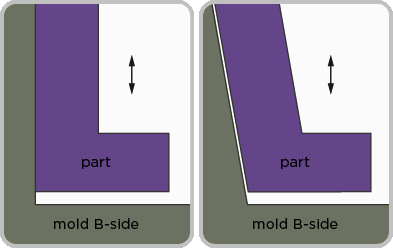
Guide to Good Looking Molded Parts
By Proto Labs
CAD/CAM/CAE injection molding Plastic Protolabs ProtomoldProtomold design tips illustrate how to minimize blemishes, marks and flaws in injection molded parts.
First, the bad news: injection molded parts are subject to a host of cosmetic flaws including sink, gate vestiges, ejector pin blemishes, drag marks, texture flaws, knit lines, burns, flash, and inconsistent coloring. The good news is that adherence to basic design rules will eliminate many of these problems. Thoughtful planning will further reduce the risk. And judicious prototyping will allow you to eliminate virtually any avoidable problems that remain.
The first step is to determine just how important cosmetics will be to your design. In a faceplate, looks may be your first consideration. In an internal part, they may be your last, freeing you to focus on other matters like function and cost. In some cases, improving appearance will require tradeoffs, but this is not always the case. Good function and good manufacturability often go hand-in-hand with good appearance.
For example, proper attention to draft doesn’t just ensure ease of ejection; it prevents unsightly drag marks (see Figure 1). Maintaining even wall thickness helps prevent functional weakness due to incomplete filling and poor fit due to warp, but it also helps prevent unsightly sink in thick areas and the flash and burn that can result from overly high injection pressures needed to force resin though thin sections. In short, following standard design guidelines will help prevent many cosmetic flaws.

Figure 1: Without draft (left), the part drags along the entire vertical side; but by adding draft (right), the part falls free from the mold upon ejection.
This is where the tradeoffs begin, where gains in one area may require sacrifices in another. Start by ordering your priorities. Certain requirements may impact appearance by limiting your choice of resins. Glass filled nylon, for example, is very strong but cannot be given a smooth finish regardless of how much the mold surface is polished. Similarly, a TPE like Santoprene provides excellent elasticity, but will have, at best, a matte finish.
Acetals like Delrin offer excellent resistance to solvents and wear due to friction, but can develop an “orange peel” finish as they cool. In short, if your requirements are very specific and limit your choice of resins, they may also limit your cosmetic options, at least as far as finish is concerned. If, on the other hand, your material choice is less constrained, resins like ABS and polycarbonate are easy to mold and will give you precisely the finish designed into your mold.
Many cosmetic decisions cross the boundaries of material and design. Knit lines form where cooling flows of resin meet, typically after parting to flow around a core in a mold or where flows from multiple gates meet (see Figure 2). Choice of resin can impact the likelihood of knit lines, but even if they do not weaken the part, they can leave an unsightly line. How visible it is may depend on the color of the resin. Light reflection can make knit lines in black resin very apparent, while the exact same line in white resin will be far less obvious.

Figure 2: Knit lines may form when the resin flow is divided by an obstacle or hole and then meets again on the other side.
There are other addressable issues that affect specific types of resin. Delrin, as mentioned above, can “crinkle” as it cools, a problem that can be minimized by avoiding excessive or inconsistent wall thickness. As polycarbonate cools it can shrink and leave internal voids where thick walls meet. In an otherwise well-designed part these may not cause functional problems, but they can be a cosmetic problem in clear resin in which the “bubbles” are visible. If you must use a clear polycarbonate, the mold can be redesigned to shorten the distance resin must travel, allowing the press to “pack” the mold before the resin cools too much to fill the void.
Resins that are good at filling small details in a mold can also have an increased tendency to “flash,” i.e., to force their way into the parting line of the mold, leaving material that must be trimmed in a secondary operation. A mold in which material must be forced through thin areas will require higher injection pressure to fill the mold, which, in turn, will increase the likelihood of flash. The problem can be addressed either by eliminating the mold features that require higher injection pressure or choosing a resin that is less prone to flash.
Finally, there are issues of mold design—gate and ejector placement—that impact a part’s final appearance. Protomold’s designers will endeavor to minimize the kinds of problems described above, but all molds require gates and ejectors, and these will leave their marks on the finished parts. If this could be a problem, you should bring it to the attention of our engineers before your order is finalized.
Clearly, there are many issues that can impact cosmetic outcomes. Some involve “cross-coupled” variables and are discussed in more detail in a free cosmetics white paper available on Protolabs’ website. Still others may be difficult to anticipate and will only show up when prototypes are made, allowing you to try other resins or, if necessary, redesign your part before committing to full-scale production.
To get more injection mold design tips like this, check out Proto Lab’s website or check out their Design Tips newsletter.
www.protomold.com
